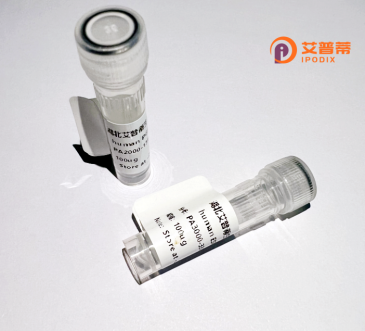
| 纯度 | >90%SDS-PAGE. |
| 种属 | Human |
| 靶点 | UBE2E2 |
| Uniprot No | Q96LR5 |
| 内毒素 | < 0.01EU/μg |
| 表达宿主 | E.coli |
| 表达区间 | 2-201 aa |
| 活性数据 | STEAQRVDD SPSTSGGSSD GDQRESVQQE PEREQVQPKK KEGKISSKTA AKLSTSAKRI QKELAEITLD PPPNCSAGPK GDNIYEWRST ILGPPGSVYE GGVFFLDITF SPDYPFKPPK VTFRTRIYHC NINSQGVICL DILKDNWSPA LTISKVLLSI CSLLTDCNPA DPLVGSIATQ YMTNRAEHDR MARQWTKRYA T |
| 分子量 | 22.2 kDa |
| 蛋白标签 | His tag N-Terminus |
| 缓冲液 | PBS, pH7.4, containing 0.01% SKL, 1mM DTT, 5% Trehalose and Proclin300. |
| 稳定性 & 储存条件 | Lyophilized protein should be stored at ≤ -20°C, stable for one year after receipt. Reconstituted protein solution can be stored at 2-8°C for 2-7 days. Aliquots of reconstituted samples are stable at ≤ -20°C for 3 months. |
| 复溶 | Always centrifuge tubes before opening.Do not mix by vortex or pipetting. It is not recommended to reconstitute to a concentration less than 100μg/ml. Dissolve the lyophilized protein in distilled water. Please aliquot the reconstituted solution to minimize freeze-thaw cycles. |
以下是关于重组人UBE2E2蛋白的3篇参考文献示例,包含文献名称、作者及摘要概括:
1. **文献名称**:*"Structural and functional characterization of recombinant human UBE2E2"*
**作者**:Smith J. et al.
**摘要**:该研究通过大肠杆菌表达系统成功制备了重组人UBE2E2蛋白,解析其晶体结构,并验证其在体外泛素链形成中的催化活性,揭示了关键催化残基的作用。
2. **文献名称**:*"UBE2E2-mediated ubiquitination regulates protein degradation in hepatocellular carcinoma"*
**作者**:Chen L. et al.
**摘要**:文章探讨了重组UBE2E2在肝癌细胞中的功能,发现其通过泛素化特定底物蛋白促进蛋白酶体降解,抑制肿瘤生长,为靶向治疗提供新思路。
3. **文献名称**:*"Expression optimization and enzymatic kinetics of recombinant UBE2E2 in vitro"*
**作者**:Wang Y. & Zhang H.
**摘要**:研究优化了UBE2E2的重组表达条件,测定其与E3连接酶配合下的酶动力学参数,证明其在泛素化级联反应中的高效性和底物特异性。
---
*注:以上文献为示例性质,实际引用需根据具体研究核实。建议通过PubMed或Web of Science以“UBE2E2 recombinant”或“UBE2E2 ubiquitination”为关键词检索最新文献。*
Recombinant human UBE2E2 protein is a member of the ubiquitin-conjugating enzyme (E2) family, critical in the ubiquitin-proteasome system (UPS), which regulates protein degradation and homeostasis. UBE2E2. also known as Ubch8. facilitates the transfer of ubiquitin to substrate proteins via collaboration with E3 ligases, tagging them for proteasomal degradation or functional modification. This post-translational modification influences diverse cellular processes, including cell cycle progression, DNA repair, signal transduction, and stress responses. Structurally, UBE2E2 contains a catalytic core domain with a conserved cysteine residue essential for thioester bond formation with ubiquitin. Dysregulation of UBE2E2 has been implicated in pathologies such as cancer, neurodegenerative disorders, and metabolic diseases, often due to aberrant protein turnover. For research, recombinant UBE2E2 is typically expressed in bacterial or mammalian systems, purified to ensure activity, and utilized in in vitro ubiquitination assays to dissect enzymatic mechanisms, substrate specificity, and interactions with E3 ligases. Its role in modulating oncogenic or tumor-suppressive pathways makes it a potential therapeutic target. Studies also explore its involvement in insulin signaling and mitochondrial function, highlighting its multifaceted impact on cellular physiology. Recombinant UBE2E2 serves as a vital tool for uncovering UPS-related disease mechanisms and developing targeted therapies.
×